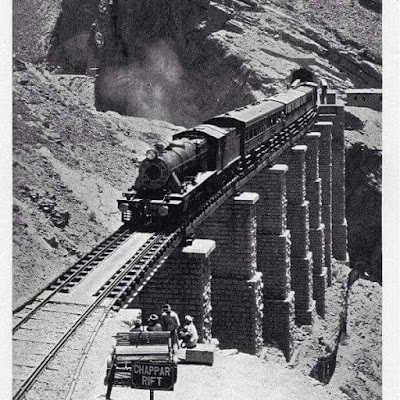Sibi-Harnai railway track
The projected railways were two in number a broad gauge line was to be constructed for heavy traffic through the Harnai passes and a light line through the Bolan passes. Both were start from Sibi at the foot of the mountains, diverging there to unite at Quetta the two lines forming an oval with the stations of Sibi and Bostan at the opposite ends.
 |
| Harnai Sibi District |
The length of the Harnai line was about double that of the Bolan line which was to have steeper gradients and to carry only light traffic. It was decided that the work should be carried out under the military and not under the Public Works, Department and Colonel James browne who had been selected as engineer of the Harnai line and who had already made a great reputation both as an engineer and a Political officer and had great control over the wild tribes of borderland.

Sibi Harnai Railway
During the remaining months of the cold weather of 1883 a certain amount of work was done on the lower part of the line.
The portions of the two lines between Sibi and Pishin that by the Harnai valley and that by the Bolan Pass also suffered severely from floods. The latter was constructed originally under pressure of the war-scare of 1885, as a temporary line pending the completion of the Harnai valley line but it was afterwards in opposition to the advice of Sir R. Sandeman retained as a permanent line on its original alignment in the river bed. It was completed wrecked in the floods of 1890 and in November 1891 a new line was commenced, proceeding from nari Bank near Sibi, through the Mushkaf valley and joining the old line in the Bolan Pass near kohlu a distance of 57 miles.
 |
| Chapper Rift bridhe Harnai |
The Harnai valley line was also constructed in the first instance without proper preliminary inquiry and the result has been that part of the Sharigh section are so unstable from recurring landslips that costly re-alignment may be necessary before the line can be regarded as a reliable means of communication.
Besides the Railway Numerous Military Roads were constructed North and East of Quetta and the great Imperial line of communication between Quetta and Dera Ghazi Khan by the Bori valley was finally completed and bridged in 1890-91. Considerable progress was also made with another Imperial line connecting Loralai with the Zhob valley with the Gumal Pass and the Punjab and roads were made between the Harnai railway station and Loralai through the Mahrab Tangi one of the grandest passes in Balochistan and between Harnai and Quetta. Altogether at the end of 1891 there were in Balochistan 1520 miles of road of which 376 miles were bridged and metaled.
The existing irrigation from the nari river near Sibi was improved by the construction of a permanent head and an underground conduit called the Zhara Karez was also completed and loans were granted on easy terms to agriculturists for construction of minor irrigation works.
No comments:
Post a Comment